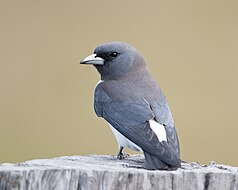Yuwi Paree Toolkoon National Park
| Yuwi Paree Toolkoon National Park | ||
|---|---|---|
| White-bellied Swallow Star ( Artamus leucorynchus ) | ||
|
|
||
| Location: | Queensland , Australia | |
| Specialty: | Island, birds | |
| Next city: | 9 kilometer (s) from Mackay | |
| Surface: | 34.1 ha | |
| Founding: | 1998 | |
The Yuwi Paree Toolkoon National Park (English Yuwi Paree Toolkoon National Park , formerly Round Top Island National Park ) is a 34.1 hectare national park in Queensland , Australia . It is part of the Great Barrier Reef , a UNESCO World Heritage Site .
location
The park consists of one island, Round Top Island . It is nine kilometers east of Mackay . In contrast to the coral islands of the Great Barrier Reef , 180 kilometers to the east, Round Top Island is of continental origin.
In the immediate vicinity in the Coral Sea are the South Cumberland Islands , Northumberland Islands and Broad Sound Islands national parks .
Flora and fauna
The island, which is 600 meters wide and 600 meters long, is covered by grassland on the southeast side, and dry rainforest and shrubbery grows on the northwest side. Apart from a small pebble beach to the west, the coast is rocky.
In the sea off the island there are smaller fields of sea grass .
White-bellied sea eagles ( Haliaeetus leucogaster ), white-bellied swallowstar ( Artamus leucorynchus ) and copper- necked pigeon ( Geopelia humeralis ) are native to the island . It is also home to one of the few vertebrates that can reproduce through parthenogenesis , the Australian gecko Heteronotia binoei .
Individual evidence
- ↑ Australian Government - CAPAD 2010 ( MS Excel ; 170 kB), DSEWPaC , accessed on January 7, 2013 (English)
- ↑ Australian Government - CAPAD 2004 ( Memento from October 12, 2012 in the Internet Archive ) ( MS Excel ; 129 kB), DSEWPaC , accessed on January 7, 2013 (English)
- ^ A b Mackay Coast Study. Retrieved January 1, 2019 .
- ↑ Official Park Website - Species List , Queensland Parks and Wildlife Service , accessed October 7, 2012

